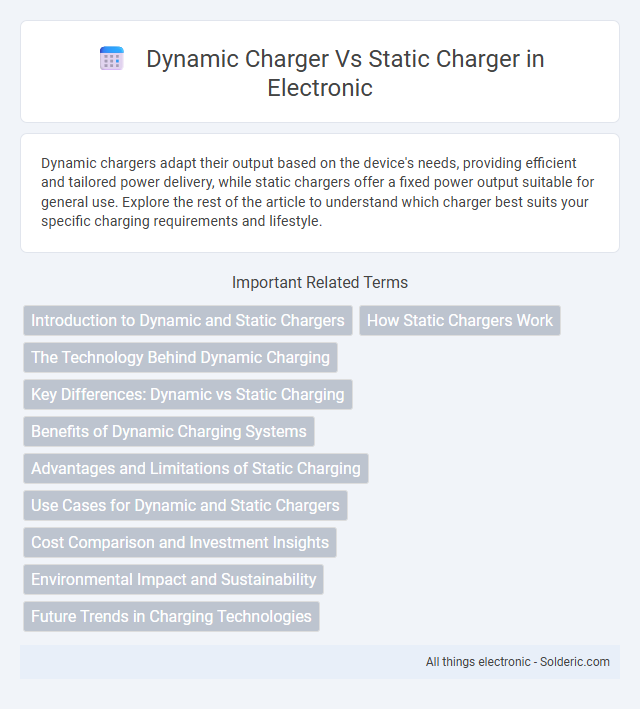Dynamic chargers adapt their output based on the device's needs, providing efficient and tailored power delivery, while static chargers offer a fixed power output suitable for general use. Explore the rest of the article to understand which charger best suits your specific charging requirements and lifestyle.
Comparison Table
| Feature | Dynamic Charger | Static Charger |
|---|---|---|
| Charging Method | Wireless charging while in motion | Plug-in or wireless charging at a fixed spot |
| Use Case | Electric vehicles on the move, public transit | Home, office, or parking lot charging |
| Charging Speed | Moderate, dependent on movement speed and system efficiency | High, stable power supply |
| Infrastructure | Requires embedded road coils or tracks | Requires charging stations or wall outlets |
| Cost | High installation and maintenance cost | Lower installation cost; maintenance varies |
| Convenience | Continuous charging without interruption | Charging requires vehicle to be stationary |
| Applications | Fleet vehicles, buses, delivery trucks | Personal vehicles, home charging |
Introduction to Dynamic and Static Chargers
Dynamic chargers transfer energy wirelessly to electric vehicles in motion through embedded road technology, enabling continuous charging without stopping. Static chargers require vehicles to be parked and connected to a fixed charging station, providing energy replenishment during idle periods. The integration of dynamic chargers supports extended driving ranges and reduces downtime, while static chargers remain essential for convenient, stationary energy access.
How Static Chargers Work
Static chargers generate a constant electrostatic field by applying a fixed voltage to stationary conductive plates or surfaces. These chargers transfer electric charges directly to nearby objects without any movement, effectively neutralizing or attracting static electricity. Your devices benefit from this predictable charge delivery, ensuring stable and consistent performance in applications requiring controlled static control.
The Technology Behind Dynamic Charging
Dynamic charging technology uses electromagnetic fields embedded in road infrastructure to transfer power wirelessly to vehicles in motion, enabling continuous energy supply without the need for stationary stops. Static charging relies on traditional plug-in systems where vehicles must be parked to connect to charging stations, limiting charging sessions to fixed locations. Advances in dynamic inductive charging coils and real-time energy management software optimize power transfer efficiency, reducing energy loss and enabling seamless integration with smart grid systems.
Key Differences: Dynamic vs Static Charging
Dynamic charging transfers power wirelessly to moving electric vehicles through embedded roadway systems, enabling continuous energy supply without stopping. Static charging requires vehicles to be stationary, using conventional plug-in or wireless pads that connect for a fixed period to recharge batteries. Your choice impacts infrastructure cost, convenience, and charging efficiency, with dynamic charging offering seamless energy while driving and static charging being more widespread and accessible.
Benefits of Dynamic Charging Systems
Dynamic charging systems offer continuous power delivery to electric vehicles while in motion, significantly extending driving range and reducing the need for frequent stops. By enabling seamless energy transfer through embedded road infrastructure, these systems enhance efficiency and convenience compared to static chargers. The integration of dynamic charging supports sustainable transportation by lowering battery size requirements and optimizing energy usage.
Advantages and Limitations of Static Charging
Static chargers offer reliable, consistent power delivery without the need for moving components, resulting in lower maintenance and longer device lifespan. They excel in controlled environments where devices remain stationary, ensuring efficient energy transfer with minimal risk of interference. However, static charging limits mobility and flexibility, as your device must remain in close proximity to the charger, restricting use during the charging process.
Use Cases for Dynamic and Static Chargers
Dynamic chargers are ideal for electric vehicles in motion, such as buses on urban routes or delivery trucks operating continuously, enabling charging without stopping. Static chargers suit stationary applications like home garages, public charging stations, and workplaces where vehicles remain idle for extended periods. Your choice depends on operational needs, balancing convenience, efficiency, and infrastructure availability.
Cost Comparison and Investment Insights
Dynamic chargers typically incur higher initial investment costs due to advanced technology and infrastructure requirements, whereas static chargers offer lower upfront expenses with simpler installation. Operating costs for dynamic charging can be more economical over time, benefiting from continuous energy supply and reduced battery degradation, contrasted with static chargers' potential for higher maintenance and downtime. Investors should weigh long-term savings and scalability of dynamic chargers against the lower entry barrier and established technology of static chargers for informed financial decisions.
Environmental Impact and Sustainability
Dynamic chargers reduce environmental impact by enabling wireless energy transfer on the move, minimizing the need for frequent stationary charging stations and lowering infrastructure-related resource consumption. Static chargers rely on fixed locations, often requiring extensive installation and higher material use, which can increase carbon footprints and environmental degradation. Emphasizing energy-efficient dynamic charging technology supports sustainable urban mobility by decreasing overall energy waste and promoting renewable energy integration.
Future Trends in Charging Technologies
Dynamic chargers, enabling wireless power transfer to moving electric vehicles, represent a transformative future trend in charging infrastructure by reducing downtime and improving energy efficiency on highways and urban roads. Static chargers remain essential for high-speed, high-power charging at fixed locations such as homes, workplaces, and public stations, with advancements in ultra-fast charging and smart grid integration enhancing their performance. Integration of AI-driven energy management systems and renewable energy sources in both dynamic and static charging technologies will optimize power distribution and support sustainable transportation networks.
dynamic charger vs static charger Infographic

 solderic.com
solderic.com